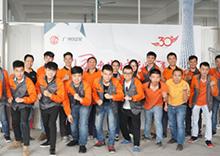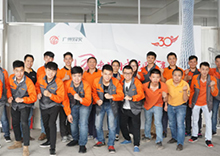Welding fourteen questions, do you know the answer?
Why is the CO2 welding more efficient than the arc welding of the electrode?
Answer:The melting rate and melting coefficient of the 1 CO2 welding electrode are 1-3 times higher than that of the arc welding electrode.
The cross section of the slope is reduced by 50% than that of electrode, and the amount of deposited metal is reduced by 1/2.
The auxiliary time is 50% of welding electrode arc welding.
Three items: the efficiency of CO2 welding is 2.02--3.88 times higher than that of welding electrode arc welding.
Why is the quality of the welded joint of the CO2 welding joint better than the arc welding of the electrode?
Answer:CO2 weld heat affected zone is small, small welding deformation; CO2 weld hydrogen content is low (less than 1.6ML/100g), porosity and crack tendency; CO2 weld forming, surface and internal defects, inspection qualified rate is higher than the smaw.
Why is the comprehensive cost of CO2 welding lower than that of electrode arc welding?
Answer:The cutting area of the slope is reduced, and the amount of filled metal is saved.
The power consumption is reduced by 65.4%.
Equipment shift cost reduced 67-80% SMAW, reduce the cost of 20-40%;
Reduce labor costs, work hours, and reduce cost 10-16%;
Save the auxiliary hours, the consumption of auxiliary materials and the correction of the cost of deformation.
In the five terms, CO2 welding can reduce the total welding cost by 39.6-78.7%, with an average reduction of 59%.
Why is there a splash in CO2 welding?
Answer:The droplets in the end of the welding wire have short circuiting contact with the molten pool (short circuiting transition). The droplets explode and produce spatter due to the effect of strong overheating and magnetic shrinkage. The output reactor and waveform control of the CO2 welder can reduce the spatter to a minimum.
Why is the impact toughness of the MAG welded joint higher than that of the CO2 welded joint?
Answer:In MAG welding, the active gas is only 20%, the transition coefficient of the alloy element in the welding wire is high, and the impact toughness of the weld is high. The active gas in CO2 welding is 100%. The manganese and silicon alloy elements in the welding wire deoxidize jointly. The alloy element transition coefficient is slightly lower, and the impact toughness of the weld is not as high as that of the MAG welding. Such as Tangshan Kobelco MG-51T wire (equivalent to ER50-6) its impact toughness at room temperature value: MAG:160J; CO2:110J.
Why is the flux cored wire protected by CO2 gas?
Answer:There are two types of flux cored wire to be differentiated according to the protection method: the flux cored wire and the self shielded wire of the drug core. The flux core welding wire is usually protected by CO2 gas. It belongs to the form of gas slag joint protection. The weld is formed well and the mechanical properties are high.
Why is there a technical requirement for the purity of CO2 gas?
Answer:General CO2 gas is a by-product of chemical production, with a purity of only about 99.6%, containing a trace of impurities and moisture, which will bring holes and other defects in the weld. Gas welding important products must use the CO2 purity of not less than 99.8%, less weld porosity, low hydrogen content, good crack resistance.
Why should the pre welding rod be strictly dried?
Answer:The welding rod often causes the process performance to deteriorate because of the moisture absorption, resulting in the instability of the arc, the increase of the spatter, and the defects such as the pores and cracks. Therefore, the welding rod must be strictly dried before it is used. The drying temperature of the general acid electrode is 150--200 C, and the time is 1 hours. The drying temperature of the alkaline electrode is 350--400 1--2, and the time is 1--2 hours. After drying, it is placed in the incubator at the temperature of 100--150.
Why are there special requirements for arc welding power supply? What are the requirements?
Answer:In order to ensure the stable welding arc burning and meet the requirements of various welding process, welding power source has the following requirements: < 1 > the static characteristics of arc welding power source (or characteristics), namely the relationship between the steady output current and output voltage, decrease characteristics (constant current) characteristic of peace (constant voltage).
A. The external characteristics of A, arc welding, TIG welding and carbon arc gouging power are decreasing (Heng Liu) characteristics. The external characteristics of B and CO2/MAG/MIG arc welding power are flat characteristics (constant voltage characteristics).
"2" the dynamic characteristics of arc welding power supply when load state instantaneous changes (such as droplet short circuiting, particle transition, jet transition), the relationship between welding power output current and output voltage and the load transient response ability to use (i.e., to characterize the dynamic response ability), referred to as "dynamic characteristics".
3. No-load voltage - the voltage displayed before the arc is introduced.
"4" adjustment characteristics - change the external characteristics of the power supply to meet the requirements of the welding specification.
Why does the arc voltage change when the arc length changes?
Answer:The longer the arc is, the higher the arc voltage is, the shorter the arc and the lower the arc voltage, which is determined by the external characteristics of the arc welding power.
Why does the current display value change when the length of the wire is changed when the CO2 welding is welded?
Answer:The longer the length of the welding wire is, the greater the resistance of the wire is. The larger the current of the resistance heat consumption, the smaller the welding current display value, and the smaller the actual welding current. So the length of the welding wire is generally set in the range of 12--20mm.
Why should the welding current and the voltage of the arc be strictly matched when CO2/MAG/MIG is welded?
Answer:When CO2/MAG/MIG is welded, adjust the welding current, that is, adjust the feeding speed of the welding wire, regulate the arc voltage, that is to regulate the melting speed of the welding wire. Obviously, the melting speed and the feeding speed of the welding wire must be equal, so as to ensure the stable welding of the arc.
When the welding current is constant, the arc voltage is high, the melting speed of the welding wire increases, the length of the arc increases, and the droplet can not transfer normally. Generally, large particles fly out and spatter increases.
When the welding current is constant, the arc voltage is low, the melting speed of the welding wire decreases, the arc length becomes shorter, the welding wire is inserted into the molten pool, the spatter is large, and the weld seam is not well formed.
The best matching effect of welding current and arc voltage is: high frequency of droplet transition, minimum spatter and beautiful weld formation.
Why does welding arc have the phenomenon of partial blowing?
Answer:In the process of welding, the center of the arc deviates from the axis of the electrode due to the interference of air flow, the effect of magnetic field or the eccentricity of the electrode.
What is the self regulating characteristic of the CO2 power supply arc system? Why is CO2 welding fine wire?
Answer: under the constant speed wire feeding system, when the arc length changes, the current and melting speed change, which makes the arc length recovery function become the self regulating function of the power arc system. The smaller the diameter of the wire used, the stronger the self regulating effect of the arc, the more stable the arc and the less spatter. This is the principle of fine wire for CO2 welding.
Why is the two output circuit of DC TIG welding connected to direct direct connection? Which metal materials are suitable for welding?
In direct direct connection, the tungsten is negative, the cathode area emits electrons, the temperature is low, the tungsten is not easy to burn, and the large welding current can be used. It is suitable for welding carbon steel, stainless steel, copper, titanium and refractory active metal molybdenum, niobium, tantalum and so on.



























